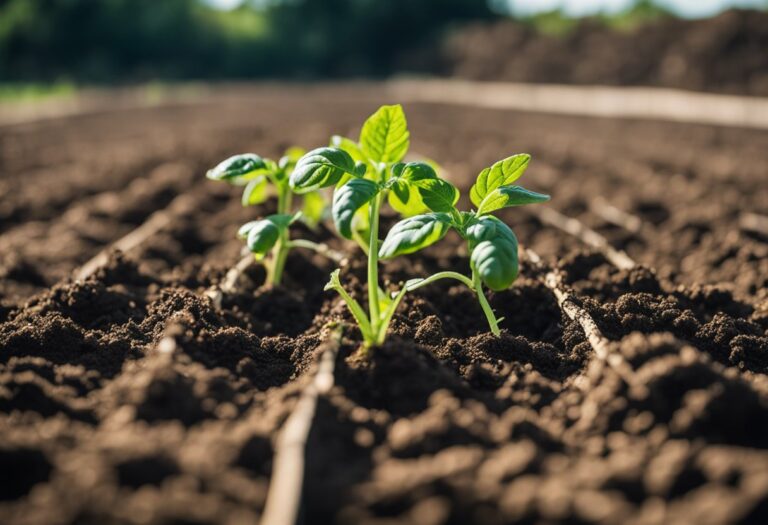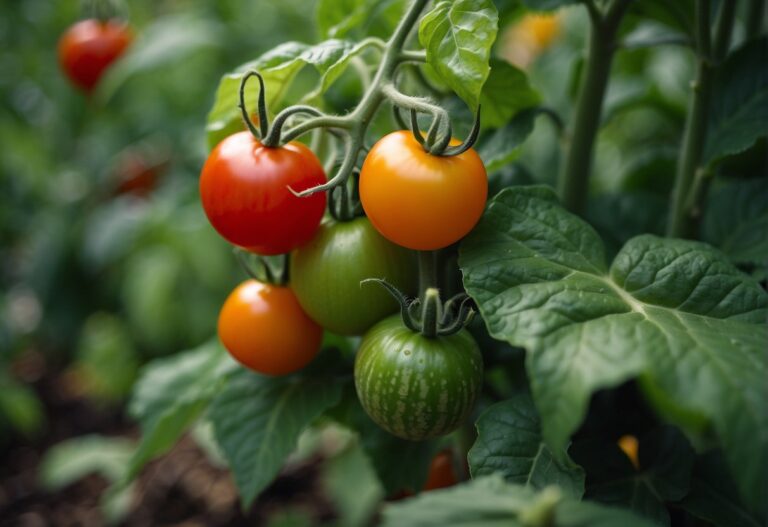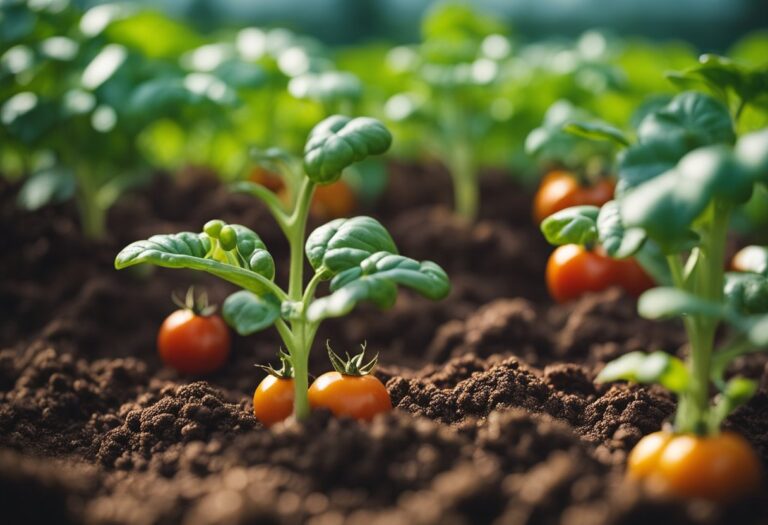Can You Plant Tomatoes 12 Inches Apart? A Guide to Tomato Spacing
Planting tomatoes is a great way to enjoy fresh, juicy tomatoes right from your own garden. But what if you have limited space? Can you plant tomatoes just 12 inches apart? The answer is yes, you can plant tomatoes 12 inches apart, but it depends on a few factors.
The ideal spacing for tomato plants is generally between 18 and 24 inches apart. However, if you are short on space, you can plant them closer together. Factors affecting tomato plant spacing include the variety of tomato, the soil quality, and the amount of sunlight and water they receive.
While planting tomatoes 12 inches apart may save space, it can also lead to potential issues. Crowded plants may not receive enough nutrients and sunlight, which can result in stunted growth and lower yields.
But with proper care and attention, you can maximize yield in limited space. In this article, we will explore the pros and cons of planting tomatoes 12 inches apart and provide tips for maximizing your yield in limited space.
Key Takeaways
- You can plant tomatoes 12 inches apart, but it depends on factors such as variety, soil quality, and sunlight and water availability.
- Planting tomatoes too close together can lead to potential issues such as stunted growth and lower yields.
- To maximize yield in limited space, consider growing determinate varieties, using raised beds or containers, and providing proper care and attention.
Can You Plant Tomatoes 12 Inches Apart?
If you are wondering whether you can plant tomatoes 12 inches apart, the answer is: it depends. While some tomato varieties can be planted 12 inches apart, others require more space to grow and thrive. Here are some factors to consider when deciding whether to plant tomatoes 12 inches apart:
- Tomato variety: Determinate tomato varieties, which grow to a certain height and produce fruit all at once, can be planted closer together than indeterminate varieties, which keep growing and producing fruit throughout the season. Indeterminate tomato varieties typically require at least 18-24 inches of space between plants, while determinate varieties can be planted as close as 12 inches apart.
- Growing conditions: If you are growing tomatoes in a container or raised bed, you may be able to plant them closer together than if you are growing them in a traditional garden bed. Container-grown tomatoes may require more frequent watering and fertilizing, but they can also be spaced closer together than garden-grown tomatoes.
- Support system: The type of support system you use for your tomato plants can also affect how close together you can plant them. If you are using a trellis or stake system, you may be able to plant tomatoes closer together than if you are using a cage system, which requires more space for the plants to grow and spread out.
If you do decide to plant tomatoes 12 inches apart, be sure to choose a determinate variety and provide them with plenty of water, sunlight, and nutrients. You may also want to consider using a support system to help the plants grow upright and prevent them from falling over.
Overall, while it is possible to plant tomatoes 12 inches apart, it is important to consider the specific variety of tomato, growing conditions, and support system before doing so.
With the right care and attention, you can successfully grow healthy, productive tomato plants, whether they are spaced 12 inches apart or further apart.
Ideal Spacing for Tomato Plants
When it comes to planting tomatoes, one of the most important factors to consider is the spacing between plants. This can have a significant impact on the overall health and yield of your tomato plants.
According to Gardening Chores, the general guideline for tomato plant spacing is between 18 and 24 inches apart. However, the specific spacing requirements for your tomato plants will depend on several factors, including the variety of tomato, the growing conditions, and the overall layout of your garden.
For example, if you are planting indeterminate tomato varieties, which are vining plants that continue growing until pruned or until they are killed by frost, you should aim for a spacing of at least 36 inches between plants.
This will allow for adequate airflow and sunlight penetration, which is crucial for healthy plant growth. On the other hand, if you are planting determinate tomato varieties, which are bred to be smaller, you can plant them more closely together. Some compact or dwarf varieties can be planted as closely as 12 inches apart, as Stellina Marfa notes.
It’s also important to consider the growing conditions when determining the ideal spacing for your tomato plants. If you are planting in a raised bed or container, you may need to adjust the spacing to ensure that each plant has enough room to grow. In general, you should aim for a spacing of at least 24 inches between plants in raised beds or containers, according to Gardening Know How.
Factors Affecting Tomato Plant Spacing
When it comes to planting tomatoes, the spacing between plants is a crucial factor that can impact the health and productivity of the plants.
There are several factors that can affect the spacing of tomato plants, including the variety of tomato being grown and the gardening method being used.
Plant Variety
The variety of tomato being grown is a key factor in determining the spacing between plants. Some tomato varieties are naturally more compact and require less space between plants, while other varieties can grow quite large and need more space to thrive.
It is important to research the specific variety of tomato you are growing to determine the optimal spacing between plants.
Gardening Method
The method of gardening being used can also impact the spacing of tomato plants. For example, if you are growing tomatoes in a container, you may need to space the plants closer together than if you were planting them in a traditional garden bed.
Similarly, if you are using a trellis or other support system for your tomato plants, you may be able to space them closer together than if they were left to grow without support.
Here are some additional factors to consider when determining the spacing of tomato plants:
- Soil fertility: If your soil is rich in nutrients, you may be able to space your tomato plants closer together than if your soil is less fertile.
- Climate: In cooler climates, tomato plants may need to be spaced farther apart to allow for better air circulation and to prevent disease.
- Plant size: As mentioned earlier, the size of the tomato plant can impact the spacing between plants. Consider the mature size of the plants when determining the optimal spacing.
- Companion plants: Some plants can be grown together with tomatoes to help improve their growth and productivity. When planting companion plants, consider how they will impact the spacing of your tomato plants.
Potential Issues with Close Spacing
When it comes to planting tomatoes, spacing is a crucial factor that affects the growth, health, and productivity of your plants. While some tomato varieties can be planted as closely as 12 inches apart, there are some potential issues that you need to be aware of.
Disease Spread
One of the main concerns with close tomato plant spacing is the increased risk of disease spread.
When plants are grown too close together, they create a humid and crowded environment that encourages the growth and spread of fungal and bacterial diseases. This can lead to a range of problems, including leaf spot, blight, and wilt.
To minimize the risk of disease spread, it’s important to ensure proper air circulation and ventilation around your plants. You can do this by pruning your plants regularly, removing any diseased leaves or branches, and spacing your plants out properly.
Nutrient Competition
Another potential issue with close tomato plant spacing is nutrient competition. When plants are grown too close together, they have to compete for nutrients, water, and sunlight. This can lead to stunted growth, reduced yields, and nutrient deficiencies.
To avoid nutrient competition, make sure to provide your plants with adequate space and nutrients. You can do this by using a high-quality soil mix, adding organic matter, and fertilizing your plants regularly. You can also use mulch to help retain moisture and prevent weeds, which can also compete with your plants for nutrients.
Overall, while it is possible to plant tomatoes 12 inches apart, it’s important to be aware of the potential issues that come with close spacing.
By taking steps to ensure proper air circulation and ventilation, and providing your plants with adequate space and nutrients, you can help minimize the risk of disease spread and nutrient competition, and ensure healthy, productive plants.
Maximizing Yield in Limited Space
If you have limited space but still want to grow tomatoes, don’t worry. There are ways to maximize your yield even in a small area. In this section, we will discuss two methods: vertical gardening and succession planting.
Vertical Gardening
Vertical gardening is a great way to grow more plants in a small space. Instead of planting tomatoes in rows, you can grow them vertically using stakes, cages, or trellises. This method not only saves space but also allows for better air circulation and sunlight exposure, which can lead to healthier and more productive plants.
When using the vertical gardening method, you can plant tomatoes 12 inches apart. However, it’s important to choose the right varieties. Indeterminate tomatoes, which grow tall and require staking or trellising, are best suited for vertical gardening.
Determinate varieties, which are bushier and don’t require staking, may not be ideal for this method.
Here are some tips for vertical gardening:
- Choose a sturdy support structure, such as a metal or wooden stake, a tomato cage, or a trellis.
- Train the tomato plants to grow up the support structure by tying them loosely with twine or clips.
- Prune the plants regularly to remove suckers and promote air circulation.
- Water the plants deeply and regularly, and fertilize them with a balanced fertilizer every two weeks.
Succession Planting
Succession planting is another way to maximize your yield in a small space. Instead of planting all your tomatoes at once, you can stagger the planting over several weeks or months. This method ensures a continuous harvest throughout the growing season and allows you to make the most of your limited space.
When using the succession planting method, you can plant tomatoes 12 inches apart. However, it’s important to keep in mind the maturity dates of the different varieties you are planting. You should plant early-maturing varieties first, followed by mid-season and late-season varieties.
Here are some tips for succession planting:
- Start with early-maturing varieties in the spring, and plant a new crop every two to three weeks until mid-summer.
- Use transplants instead of seeds to save time and ensure a more uniform crop.
- Choose disease-resistant varieties to prevent the spread of diseases.
- Rotate your crops every year to prevent soil-borne diseases.
By using these methods, you can grow tomatoes even in a small space and enjoy a bountiful harvest. Remember to choose the right varieties, provide adequate support, and take good care of your plants. Happy gardening!
Frequently Asked Questions
What are some good companion plants for tomatoes?
Tomatoes grow well with certain companion plants such as basil, marigold, and parsley.
These plants help to repel pests and attract beneficial insects to the garden. They also provide additional nutrients to the soil, which can improve the growth and yield of your tomato plants.
What kind of support do tomato plants need?
Tomato plants need support to keep them off the ground and prevent them from breaking under the weight of their fruit. You can use stakes, cages, or trellises to support your tomato plants.
The type of support you choose will depend on the variety of tomato plant you are growing and the space you have available in your garden.
How far apart should you plant peppers?
Peppers should be planted 18 to 24 inches apart in rows that are 24 to 36 inches apart. This spacing will give the pepper plants enough room to grow and produce a good yield.
What is the recommended spacing for beefsteak tomatoes?
Beefsteak tomatoes are large and require more space than other tomato varieties. They should be planted 24 to 36 inches apart in rows that are 36 to 48 inches apart. This spacing will allow the plants to grow and produce large, juicy fruits.
What is the ideal spacing for indeterminate tomatoes?
Indeterminate tomato plants can grow very large and require plenty of space. They should be planted 24 to 36 inches apart in rows that are 48 to 60 inches apart. This spacing will give the plants enough room to grow and support their sprawling vines.
What are the consequences of planting tomatoes too close together?
Planting tomatoes too close together can lead to a number of problems. The plants may compete for nutrients and water, which can result in stunted growth and a lower yield.
They may also be more susceptible to disease and pest infestations. Proper spacing is essential for healthy, productive tomato plants.



